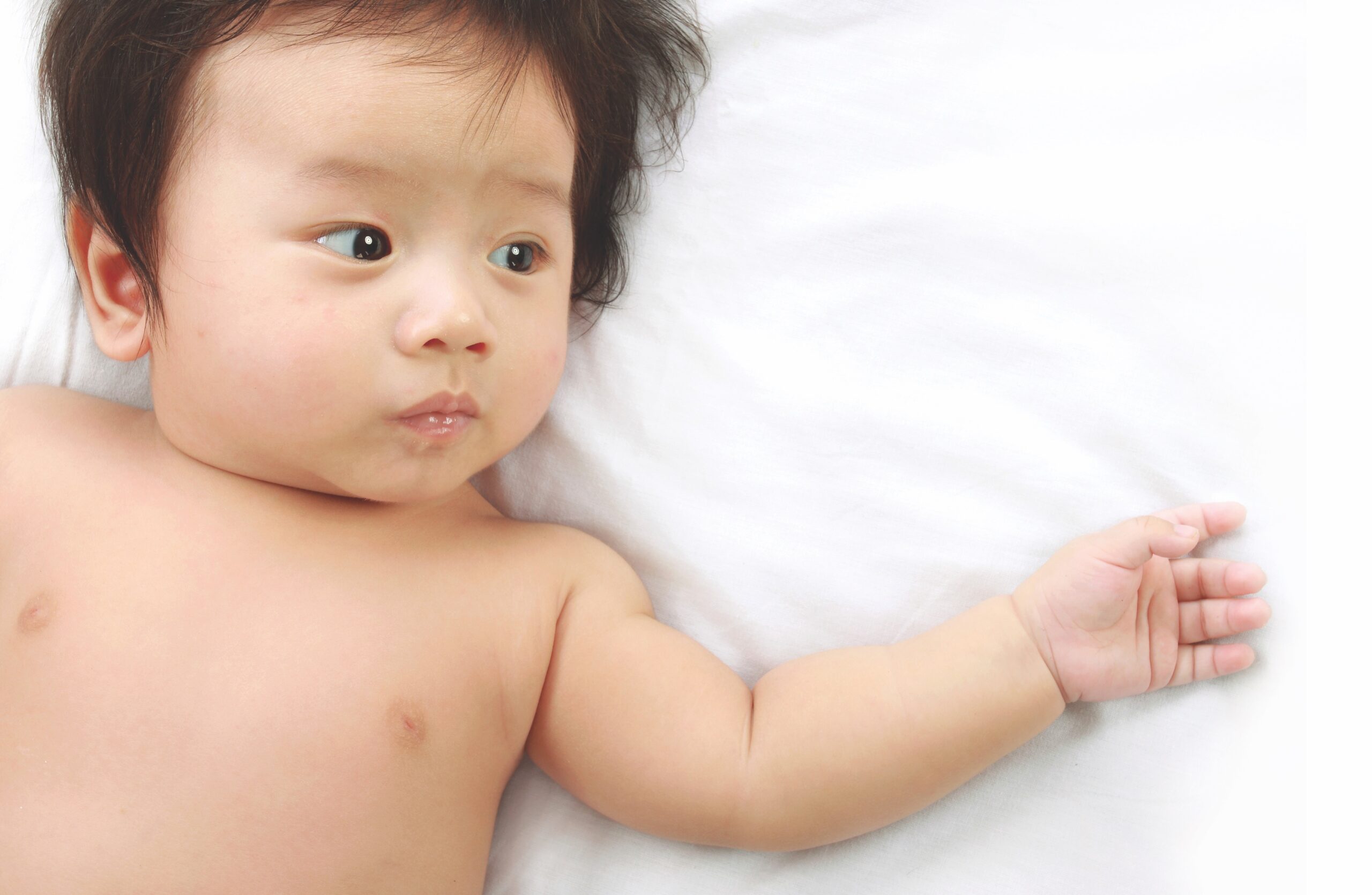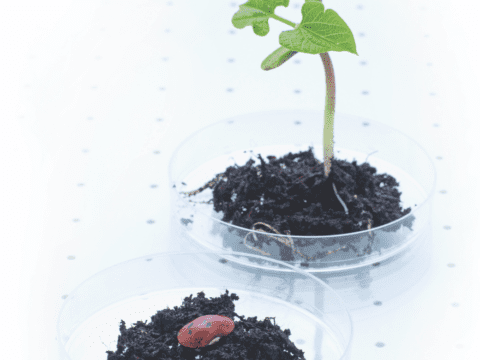I’ll never forget the first time my daughter, Grace, showed a conscience. I was trying to coax her into eating some vegetable mush when she froze, looked me in the eyes and tossed her spoon on the floor, spattering food bits everywhere. Exasperated, I shot her a stern look and channelled some old-school fatherly menace. “No, Gracie,” I intoned. “Don’t do that.”
She looked down. She went limp. She didn’t move for a full two minutes. Once I got over the initial fear that she was choking or having a seizure, I understood she was just feeling bad. She was processing. At nine months, she could perceive my change in tone, understand she had transgressed, and try to correct her moral code.
***
Where does this ability to negotiate good and bad come from? Plato imagined goodness as a perfect “form” or ideal you could aspire to, while Aristotle believed goodness arose from a fuzzy mix of circumstance and will. Adam Sparks, a researcher in the psychology department at the University of Guelph, says morality boils down to two survival mechanisms: conscience and condemnation. “Generally, we condemn others in attempts to make them behave in ways that are useful for us,” he tells me. “Our conscience helps us avoid acting in ways that will lead others to condemn us.”
In the past decade, research by a group of predominantly Canadian psychologists has revived a bygone debate about the origins of morality. Studies of infants three months and older suggest we are born with compassion for others, a penchant for fairness, the ability to tell kind from cruel actions, and a sense of justice, including the desire to see good actions rewarded and bad actions punished. Babies emerge from the womb hardwired for moral action, the studies say. We are born better or worse, according to our nature.
The scientific study of morality in babies is surprisingly new. Until recently, psychologists agreed the mind begins as a tabula rasa, a blank slate waiting to be filled with information, ideas and morals. There are many reasons for this, not least the ubiquitous proof that we develop, learn and change through interaction with our environment.
The great leap in infant cognition studies came in the 1980s, after psychologists began using “looking time” — the length of time a subject spends looking at something — to test our inborn expectations about the world. In a series of studies at Quebec-native Renée Baillargeon’s psychology lab at the University of Illinois, 14-week-old babies tended to stare longer at objects that disobeyed the laws of nature, such as floating boxes and disappearing carrots, suggesting an innate understanding of gravity and object permanence, a “naive physics,” in psych parlance. Related studies revealed babies can also grasp linguistic patterns, inertia, rules of social interaction and basic math.
More recently, psychologists have used looking time to study the moral lives of infants. Arguably the leading researcher in the field of baby morality — its “grand dame,” as Smithsonian magazine noted — is J. Kiley Hamlin, a 31-year-old assistant professor at the University of British Columbia. As a grad student at Yale’s baby lab in 2007, Hamlin co-published a landmark study in Nature that tested whether six- and 10-month-old infants distinguish helpful people from saboteurs.
After watching a puppet show where a google-eyed triangle, square or circle either helped or hindered another shape that was climbing a hill, babies were offered the chance to reach for either puppet. Sure enough, subjects reliably chose the “good” shape. Where dozens of previous experiments had explored what infants perceive or understand, the 2007 study broke ground by asking whether babies evaluate people based on their behaviour.
“We didn’t realize the potential importance of the question until after the study had finished,” Hamlin says over the phone from her office at UBC. “So it’s almost like we backed into some very exciting research.”
Hamlin and her co-authors, Montreal-born psychologist Paul Bloom and the Yale lab’s Regina-raised director Karen Wynn, later replicated the study with three-month-olds. The infants weren’t co-ordinated enough to reach, so the researchers used looking time to measure the babies’ preference. Once again, the babies tended to gaze longer at the helpful shape and avoid looking at the saboteur.
The idea that babies could make sophisticated moral judgments before they could eat solids sent ripples through the scientific community. It also caught the media’s attention: Hamlin says she has given 50 to 100 interviews since the hill study was published. “This is something that people find compelling, and it’s telling us something important about the nature of our moral and social lives,” she says.
Subsequent studies corroborated and expanded on the findings. “They tell the same story. Infants care who is helping or hindering,” Hamlin says. In another study conducted at the Yale lab, infants as young as three months old watched a puppet show in which a cat tries to open a box. One bunny helps the cat open it; another bunny slams it shut. More than 80 percent of babies either stared at or reached out for the “good” bunny. Among the youngest subjects, the three-month-olds, that number rises to 87 percent. “We’ve found babies like a character who gives a ball back after they drop it, versus someone who steals it away,” Hamlin adds. “So they like givers versus takers.”
In a 2011 study, Hamlin took her research a step further to show that babies evaluate actions in context. “If the infant knows the character and they have some reason to like him, either because he’s been nice to others or because he’s demonstrated a similarity to the infant, then they still like that character” even if he hurts others, she says. Similarly, if the target is disliked, the baby doesn’t mind as much if he is punished. “They like characters who harm those they dislike,” says Hamlin.
In still another study from the Yale lab, the vast majority of infants preferred to accept one graham cracker from a “good” bunny over two from a “bad” bunny. This willingness to sacrifice a cracker is limited, however. When the bad bunny’s crackers were bumped to eight, most children made the Faustian bargain, with only a third still favouring the “good” bunny’s crackers.
Today, a sizable crowd of researchers across North America focuses on morality in babies and children, riding a wave of popular interest in the subject. At the University of Toronto, Tina Malti has studied the emergence of emotions like respect and remorse in children, especially in the context of moral transgression. “What emotions do children attribute to themselves after pushing another child off the swing or stealing another child’s chocolate?” Malti asks.
The so-called Big Mother study published in 2013 by Harvard psychologist Felix Warneken found two-year-olds voluntarily help others, whether or not a parent asks them to or is even present. In another study published in Psychological Science, toddlers stared longer when toys were divided unfairly among two giraffe puppets. One of the authors, Stephanie Sloane, says the study proves humans have an inborn “skeleton of general expectations” about fairness. A companion article published by the Association for Psychological Science said the study shows sharing is “innate and universal.”
Paul Bloom’s bestselling book, Just Babies: The Origins of Good and Evil, is based in part on his research with Wynn and Hamlin. The cover features two newborn babies sporting hospital identification tags reading “GOOD” and “EVIL” in red capital letters. Reached by phone at his home in New Haven, Conn., Bloom said it’s plainly true that some people are born with a stronger moral foundation than others. “We’ve long known that certain traits that have to do with morality are heritable,” he says, citing studies of impulse control and aggression. “For example, there’s a population that is far more likely to commit murder, and that is males. That’s plainly a genetic difference that is exaggerated by culture.”
For her part, Hamlin says her studies show most babies choose good over bad. “So the question is, what’s going on with the babies who don’t choose the nice puppet? My best response to that is ‘probably nothing.’ Infants are one of the noisiest research populations you can get. Maybe they come in and they’re hungry. Maybe they prefer the colour red. Maybe they’re particularly right-handed, and they reach for the puppet on the right. We expect a lot of noise in our data.”
One day, longitudinal studies will show if the “immoral” babies actually turn out to be cheaters and thieves, Hamlin says. For now, it’s too early to tell.
***
In an old mansion in midtown Toronto, in an alcove that was probably once a child’s bedroom, Kang Lee studies children. Parents sign up at travelling baby shows and are later invited to Lee’s third-floor suite at the Dr. Eric Jackman Institute of Child Study, where the exits are marked with neon alphabet fridge magnets. “We see kids almost every day,” Lee says after greeting me in a crimson U of T hoodie and thick-rimmed glasses early one morning in November. “Every child gets a toy when they’re done.”
A distinguished professor at the University of Toronto, Lee has made remarkable discoveries about the interaction of the environment and the brain. He shows me a presentation he gave at the Massachusetts Institute of Technology on his most famous experiment, “Seeing Jesus in Toast,” in which subjects reported seeing faces in “pure-noise images.”
For Lee, the new research on infant morality shows babies are remarkably prosocial, or altruistic — but he sees no evidence they are born that way. “Overall, we tend to underestimate a baby’s ability to pick up information in their environment. Babies are very fast learners,” he says. “They mostly see people who are fair, and they mostly see people who are nice and non-violent. To me, that’s the more reasonable interpretation of the findings.”
For hard evidence, Lee points to research that appears to debunk a 2005 study of racial prejudice. From as young as three months old, the study published in Developmental Science found, infants prefer to look at faces matching their own race.
A subsequent study by Israeli researchers found that babies raised among both black and white faces showed no racial preference. In another study at the University of Delaware, three-month-olds preferred male faces if their primary caregiver was a man, again suggesting infants learn to make sophisticated judgments based on their surroundings.
“Among these babies, they just prefer to look at male faces. That shows you how powerful their early visual experience is,” Lee says, adding his own research into the question showed the preference doesn’t appear until around six months. “We have tested newborns, and they show no preference for different races.”
As a sample population, babies present special problems. The average three-month-old can’t talk, might doze off or melt down at any moment, and also possesses an underdeveloped prefrontal cortex, the region of the brain in charge of control and inhibition. In one of Paul Bloom’s experiments, 20 percent of the sample was lost to procedural errors, another 20 percent to “fussiness.” Bloom says it is also “exquisitely complicated” to isolate for variables in a study of pre-verbal infants.
“You have to do a lot of work to show that you are studying what you think you’re studying,” he says. “You have to control for the colour, size and shape of the stimuli. You have to worry about unconscious cues by the parent who’s holding the baby, or by the scientist.” While adult morality studies have relied on functional magnetic resonance imaging (fMRI) and chemical suppressants to record brain activity during experiments, these tools cannot be used on babies.
Along similar lines, some scientists have argued pre-verbal babies are simply not capable of making rational choices. In a blog post titled “What is wrong with Infant Looking Research,” American University psychologist Eric Charles issues a scathing critique of looking time, arguing the method is faulty. He casts doubt on the motives of researchers who use it and calls the rush to embrace the “infants are brilliant” story an “extreme” instance of psychological nativism — the view that certain abilities are hard-wired in the brain.
When I reached Hamlin, she was drafting a response to a replication of her study that directly contradicted her findings. The study, by a team in Auckland, New Zealand, concluded that Hamlin’s infant subjects reacted not to moral cues but to perceptual events, especially the colliding and bouncing of the shapes in the puppet show. “Our findings call into question the view that infants enter this world with an innate moral compass,” the authors wrote in the peer-reviewed journal PLOS ONE. Hamlin and Bloom discount the replication on technical grounds.
Next comes the challenge of defining morality, which some say doesn’t exist and others say governs every aspect of our lives. “I actually wouldn’t define morality,” Bloom says when asked to pin the term down. “But I could give a rough sense of it. It’s connected to right and wrong. It’s related to our emotions, such as shame, guilt, pride and anger. It’s related to intuitions, domains of what people eat and how people have sex. Morality is deeply entwined with our social and personal lives.” Hamlin is careful to distinguish between the types of moral judgments adults make and the simple preferences exhibited in her lab. “I don’t think I’m studying full-fledged morality here,” she tells me. “What I think I’m studying are very basic aspects of what eventually becomes a super-complex system.”
While there is no definitive proof that babies enter the world with the ability to make moral judgments, Hamlin and Bloom say the current studies support that conclusion. “It’s happening so early, it’s unlikely any particular moral input in the first, say, three months of life is causing this to happen,” Hamlin says. “So yes, they are born with the potential” for moral development. “Certain moral foundations are not acquired through learning,” Bloom concurs.
***
The night my daughter was born, she cried and cried. I paced the halls of the maternity ward with her in my arms, singing Amazing Grace to calm her, wondering self-consciously why none of the other new babies were making such a fuss. Before long, I accepted that my girl was just different than the others, more vocal, maybe more independent, certainly more single-minded. She came into this world with a unique personality.
Was she born with morality, too? “Your newborn baby has instincts and reflexes and working senses and in many ways she is amazingly competent,” writes British psychologist Penelope Leach in her classic parenting book, Your Baby and Child. For new parents, it’s easy to imagine a moral compass stirring behind a child’s bright, sympathetic eyes. New research lends scientific credibility to the notion that humans have an inborn capacity for ethical behaviour.
Still, looks can be misleading: just because an infant makes moral judgments doesn’t mean he or she began doing so at birth, let alone conception. Babies emerge from the womb with nine months of learning already accomplished, and torrents of new information stimulate still more brain growth in the first weeks and months of life. Perhaps the habits of conscience and condemnation emerge neither early nor late, but gradually, as part of development.
Paul Bloom says morality is a mix of “the unlearned, the discovered and the invented,” meaning we begin with some morality, acquire more from our families and communities, and develop still more through private, creative reasoning. It’s a polite formulation that embraces all sides of the debate and provides closure on a difficult subject. Nevertheless, the idea that some morality is “unlearned” will continue to haunt us with its most sensational implication: at least some virtue, and some corruption, is bred in our very bones.
***
This story first appeared in The United Church Observer’s February 2015 issue with the title “Little bundles of good.”















